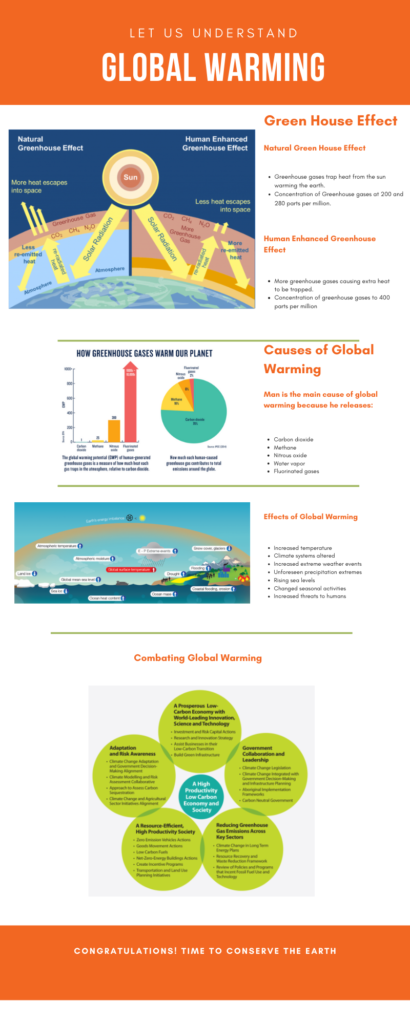Project Plan
I am going to teach my students using an infographic and screencasting. Infographics are used to teach complex subjects in a simplified manner. They represent difficult subjects that are lengthy in a clear and concise format. There are various methods and technological tools to make infographics. Nonetheless, I will use the tool taught in the course EDCI 337, Canva. Canva is said to be a tool that is gaining popularity. It is easy to use and does not require additional software to be installed in a computer because it is hosted directly in the cloud. Canva is used straight in the browser with easy to use features, such as standard templates, objects, drag and drop features, and images.
Additionally, I will combine the use of infographics together with screencasting. I will screencast the infographic and explain it for better understanding of the topic. Screencasts are used to capture the screen. I will use screencastify which was taught in the course EDC1 337 to make the screencast. Screencastify is added as an extension in Google Chrome.
Learning Outcomes
After reading the infographic on global warming learners will be able to know the following:
- Broad understanding of global warming
- Illustrate the greenhouse effect
- Describe the causes of global warming
- Explain the effects of global warming to the earth
- Elucidate the industrial steps taken to combat global warming
Original Content

Multi-media elements
The infographic is explained using Screencastify.
Discussion
Multimedia learning (MML) principles imply that the combination of words and pictures when creating learning material and during the dissemination of knowledge is better for learning than from words alone (Pastore, 2018). With the recent technological advancements, there have been many applications that create illustrations, such as PowerPoint slides, Prezi, and so on.
However, when the MML principles were first proposed, books were the main focus. Dr. Richard Mayer came up with these MML principles and identified that books can be multimedia if they include illustrations as well as printed text. Subsequently, with the current advancement, this theory has come to be applied in the creation of multimedia elements in a computer environment, such as presentations. It can be said that MML principles were initially focused on illustrations in textbooks, but it is now focused in computer based learning.
In creating multimedia elements in computer based learning, there are three instructional goals that should be achieved.
- Reduce extraneous processing: The working memory has limited capacity. Multimedia with many extraneous material increases cognitive load.
- Foster essential process: The multimedia should break large ideas into parts and give pre-training for key concepts to facilitate cognitive processing.
- Foster generative processing: The multimedia should help integrate what is presented to what is known until it is reorganized to what makes sense to a learner.
The following MML principles are used to achieve the three instructional goals:
- Modality/Split Attention: Images that narrate the story are better for learning than words and pictures. For example, in a power point presentation, if a learner has to look at the picture and read the text at the same time (same slide), then they working memory’s load is increased too fast.
- Redundancy: Presenting the same information twice in the same space increases the cognitive load. It interferes with learning.
- Coherence: Irrelevant information increased cognitive load. It is necessary to remove extraneous material to increase learning. The working memory is limited and should be occupied by only the relevant information.
- Signaling: Another way of reducing cognitive load is by inserting cues. Signaling allows the learner to focus mostly on the important terms, concepts, or ideas. The important terms may be highlighted or written in bold.
- Interactivity: This is a method that allows the learners to control the pace of the instructions. It assumes that different learners do not understand the instructions or theories at the same rate. Therefore, allowing learners to pause, playback, or jump to the next instructions improves learning performance.
In conclusion, multimedia principles are necessary when working with multimedia in computer based learning. The main focus is to reduce the cognitive load that the working memory is undergoing during the learning process. Proper learning performance takes place when working memory is able to select information from sensory memory, organize information, and integrate the information with prior knowledge.
References
MacMillan, A. & Turrentine, J. (2021, April 7). Global warming 101. NRDC. https://www.nrdc.org/stories/global-warming-101
Pastore, R. (2018, August 16). What is multimedia learning? What is multimedia?. YouTube. https://www.youtube.com/watch?v=g-sknUVq1mk